An article by Sebastian Hartmann & Stephan Kaufmann
A paradigm shift is driving an evolution across professional services: The clients of professional services firms (short “PSF,” e.g., legal, consulting, accounting, creative, tech services) are increasingly looking for clearer value propositions with more tangible outcomes. These clients are now (and more than ever) open to using alternative providers, more digital solutions, and innovative business models. Some of this even happens entirely under the radar of traditional law firms, consultancies, and their likes.
Consequently and in response to clients, providers have more broadly begun to adjust their pricing schemes, e.g., from input orientation (hourly/daily rates) towards throughput- or output-oriented pricing. To win and retain clients, PSFs must now deliver more reliably and efficiently (on time, in quality, in budget, etc.). Doing so requires a much more systematically managed value chain – and also the use of more deeply embedded and client-facing technology. These changes are affecting operating models and even business models significantly across the professions by now. We see different management levers evolving into new functions and roles.
Some typical examples may be found in the frequently observed innovation initiatives, ecosystem, and alliance management efforts or cloud transformation and technology platform projects. Today, these examples are quite common amongst major global PSFs. And at the center of all this change, we see a new management dimension taking shape:
Solutions.
Yes, even the most traditional and genuinely expertise focused PSFs are beginning to adopt the term “solution,” which has been mostly coined by technology providers up until now. Solutions are becoming the third core dimension and management object, which complements the two traditional focus areas – clients and capabilities. Solution thinking takes place at the intersection of business, technology, and, most importantly, the client experience.
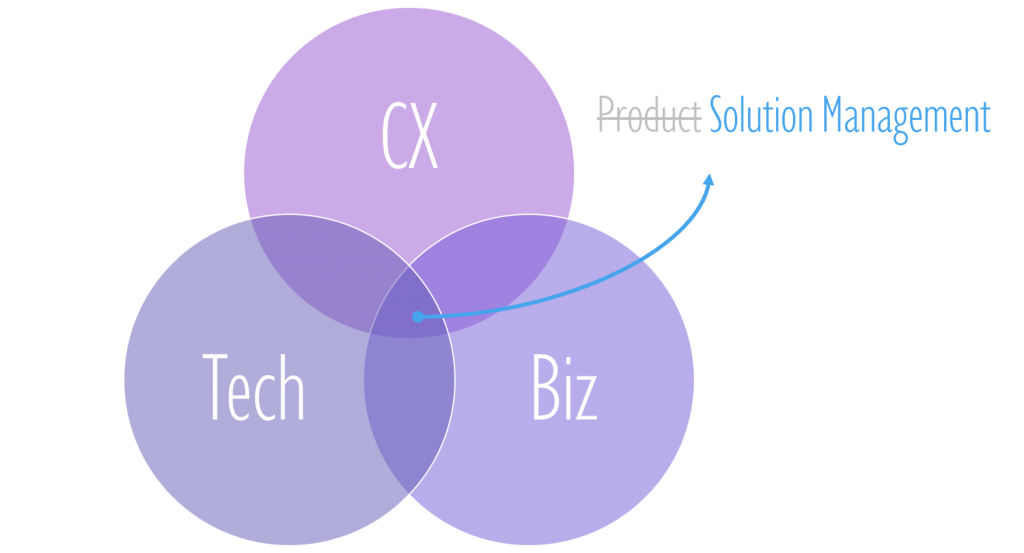
Embracing the term “solution” drives a critical mindset shift for the professions – and a new way of looking at the business itself in a client-centric way: Solutions are defined by the existence of client problems, challenges, issues. Quite literally. Therefore, the firm is no longer determined by its capabilities (aka the professionals – lawyers, consultants, accountants, etc.). Solution thinking makes the conventional distinction between lawyers and non-lawyers or client-facing and non-client facing roles completely irrelevant (apart from all the other reasons why this distinction is increasingly obsolete and unacceptable). Instead, the solution moves to the center of attention, which is much more in line with the client’s perspective: The firm offers a portfolio of solutions. These solutions directly address and solve very real client issues. How these solutions are designed and delivered is a different question – a question that can now be answered differently, too.
The following taxonomy map explains how professional services are architected through this emerging lens (from left to right):
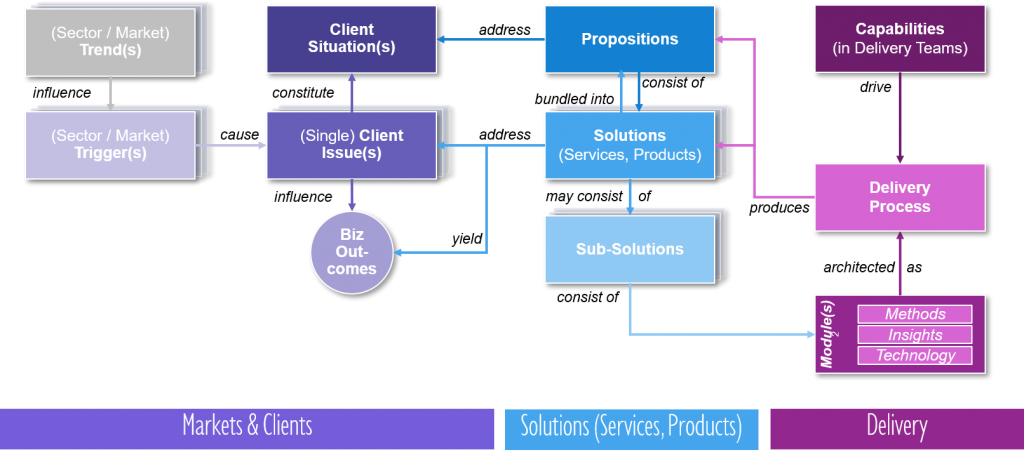
So, the key foundation for the next generation of professional services is a different view of the business itself. It is about a framework, a “lens,” to grasp, design, and optimize the firm “architecture” – from the top all the way down to the actual solution offerings.
Let’s think of this management lens as a “canvas.” This canvas helps leaders and managers in PSFs
- to solve client issues,
- to design solutions with outstanding performance and market fit,
- to develop solutions quickly as demands surface,
- to keep improving solutions and their design, components, etc.,
- to enable reliable delivery performance of solutions – both for clients and the firm,
- to design for new levels of scalability of solutions and delivery operations,
- and to guide discussions about the firm’s management, structure, and processes.
In order to help PSFs with these questions, we have created the “Solution Design Canvas.”Inspired by Osterwalder’s Business Model Canvas, this framework is tailored to the specific needs, the characteristics, and the next-generation architecture of professional services. The “Solution Design Canvas” follows the client-centric taxonomy outlined above – and serves us as a design tool, discussion, or ideation framework.
Over the past couple of years, we have applied, tested, and refined the model for hundreds of solution designs, architecture discussions, and digital optimization & transformation workshops in consulting, accounting, tax, and legal contexts. We have found this canvas to fill a critical gap in the design thinking toolbox for the professions. Especially design exercises for new offerings or improvements to existing ones benefit from its structure and client focus:
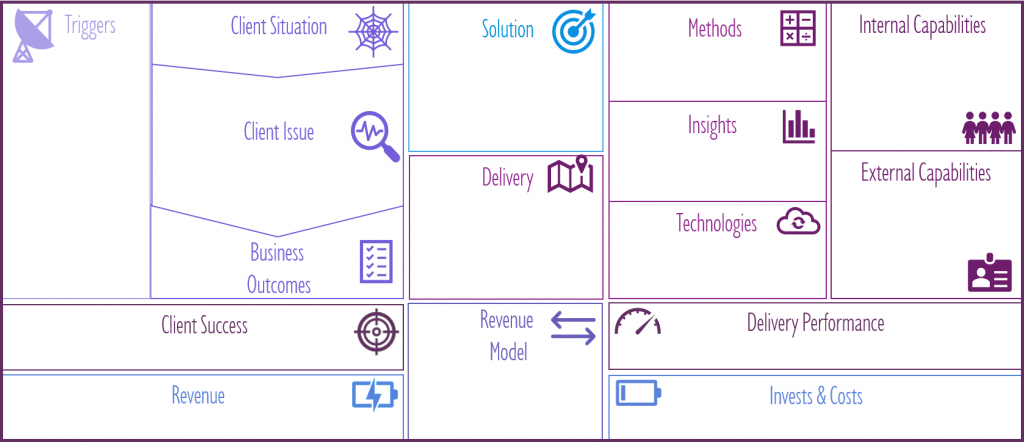
The left half of the canvas focuses on the essential question: “Do clients want & need this?” It draws a clear picture of the demand. This demand (and its market size) needs to be sufficiently large to sustain solution design investments. The articulation of triggers helps to understand what drives the overarching client situation. We often use it as the typical starting point. The clear definition of the resulting client issue – the specific challenges, problems, and pains experienced by the target client – are at the demand side’s core. Typically, these issues are measured in terms of impacted business outcomes (e.g., revenues, costs, risks). Lastly, clients that experience such issues must be clearly identifiable and, of course, addressable.
The right half of the canvas is about the high-level architecture of the solution and the question, “Can our firm deliver?” The canvas contains all required building blocks to deliver, manage and scale the solution. Access to key capabilities internally or through external partnerships must be secured. Methods, insights and technologies need to be orchestrated. Overall, this part culminates in the delivery – the specific value chain design of the solution. That is where “the rubber meets the road, ” and client value is being delivered. This solution decomposition is also one of the critical aspects of managing the described paradigm shift for legal, consulting, tax, or accounting service providers.
The lower parts of the canvas underpin the solution design with customer success, delivery performance indicators, and the financial model. It answers the management question, “Should we do this?” Here, the canvas depicts the measurable indicators of client success and the firm’s delivery performance. These fields are critical to managing the solution. The resulting revenue model should reflect these mechanics, help to align both sides, and ensure a beneficial business case for the firm.
The Solution Design Canvas, therefore, facilitates the design of desirable, feasible, and viable solutions – maximizing both clients’ and the professional services firm’s success
The following guiding questions for each of the central building blocks of the canvas should guide users with their use cases:
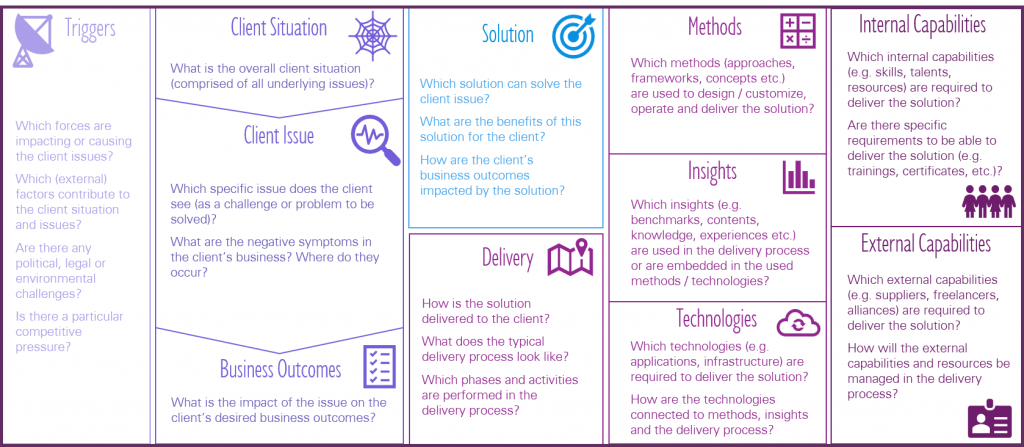
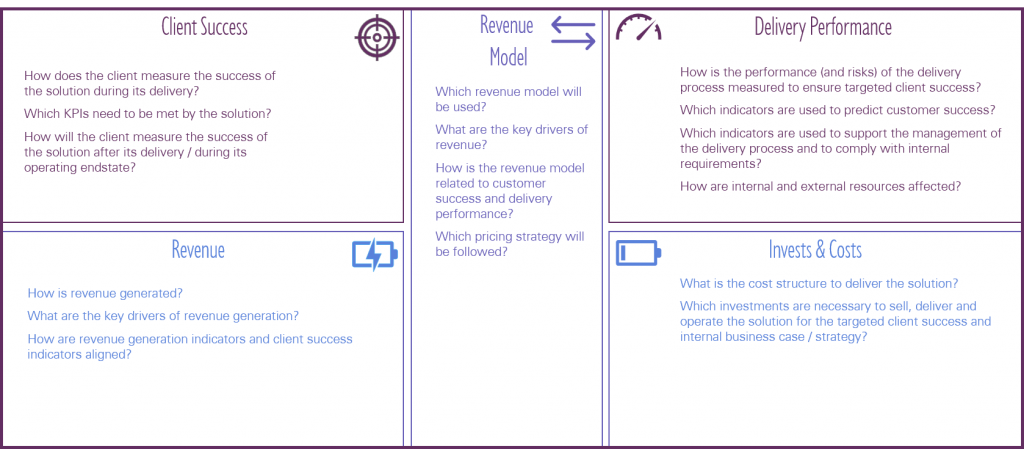
When we surveyed hundreds of executives, leaders, and managers across professional services last year, a stunning 48% of them reported to expect radical or major changes to their business over the next three years – through new or changing business models and solutions. As these firms are facing the current COVID-19 crisis and its aftermath, we are now observing an even more significant acceleration towards virtual delivery and digital business models. Managing this transformation is the key challenge for leaders and managers today.
The key to mastering the journey is the client. Designing for the emerging future of next-generation professional services requires a new mindset and new management tools – and methods like design thinking to get us there. The proven and tested Solution Design Canvas, which marries the traditional capability-oriented thinking in many firms with strong client-centricity and digital business models, is, therefore, an increasingly important management and design tool on this journey towards next-generation professional services.
Feel free to get in touch with me to receive some high-resolution versions, guidance, support, and practical advice regarding the application of the Solution Design Canvas in your firm, for your clients and solutions!